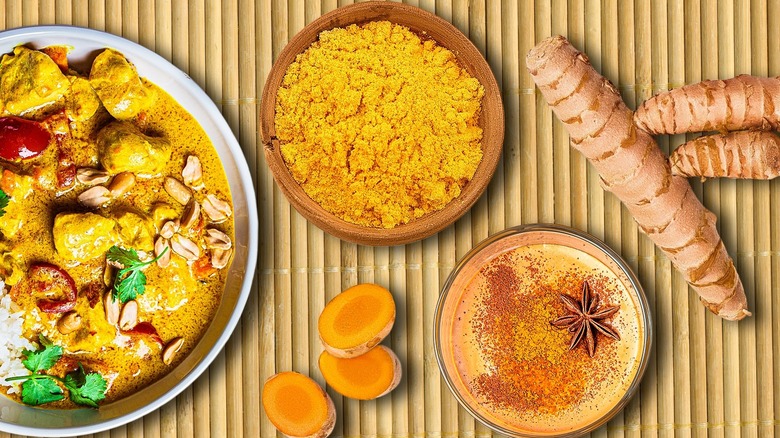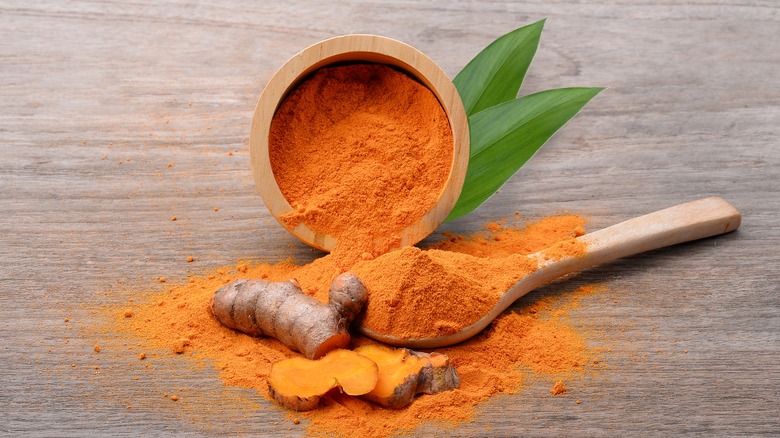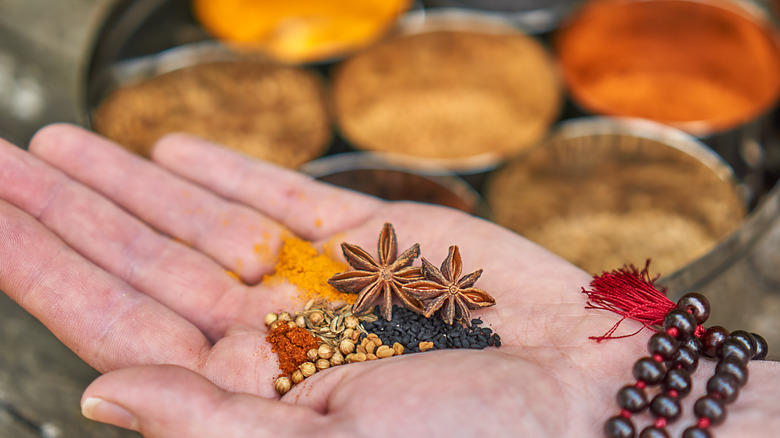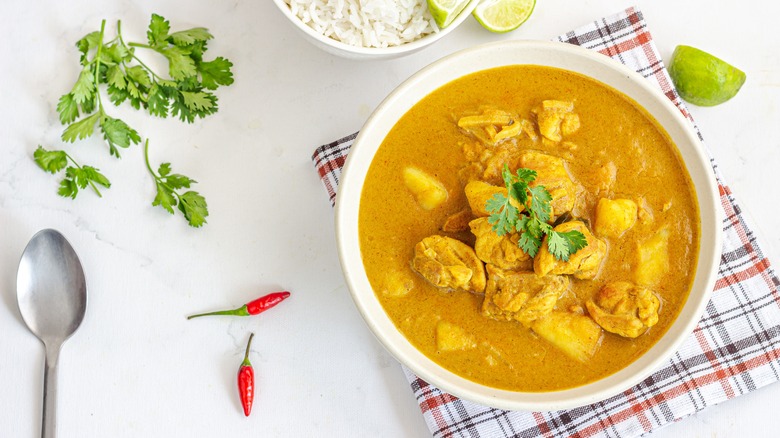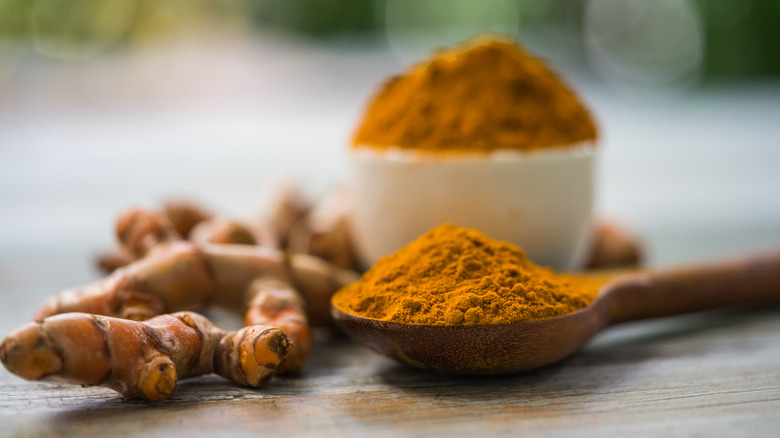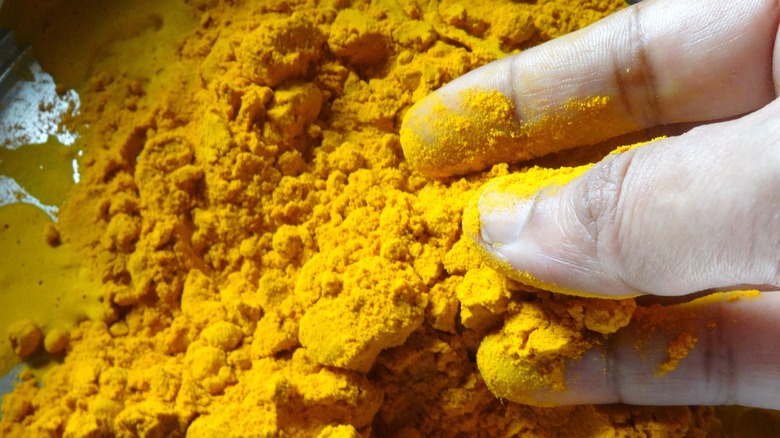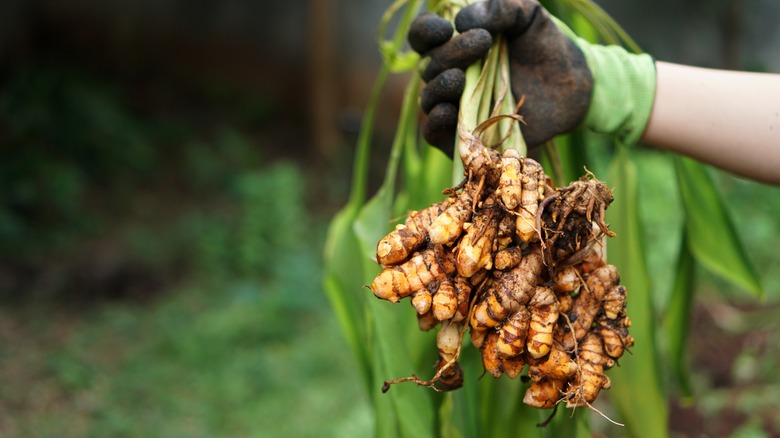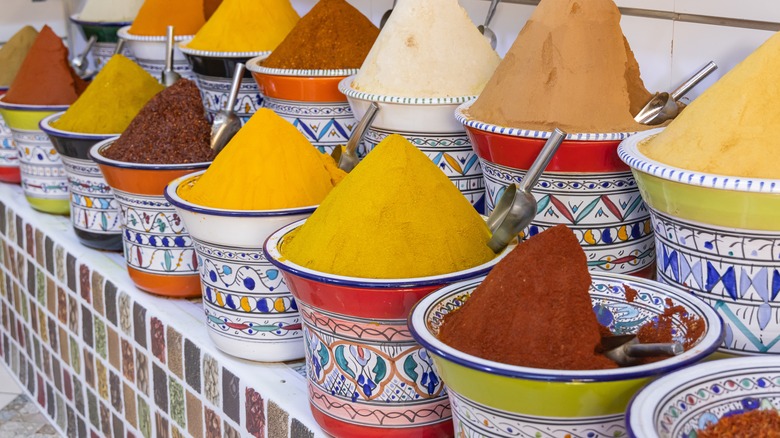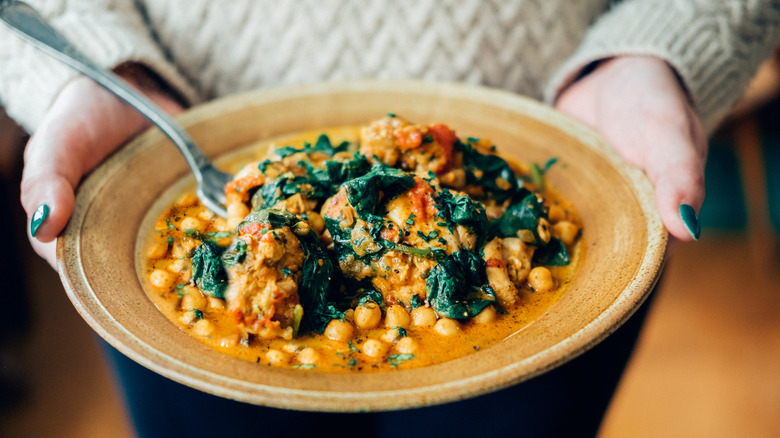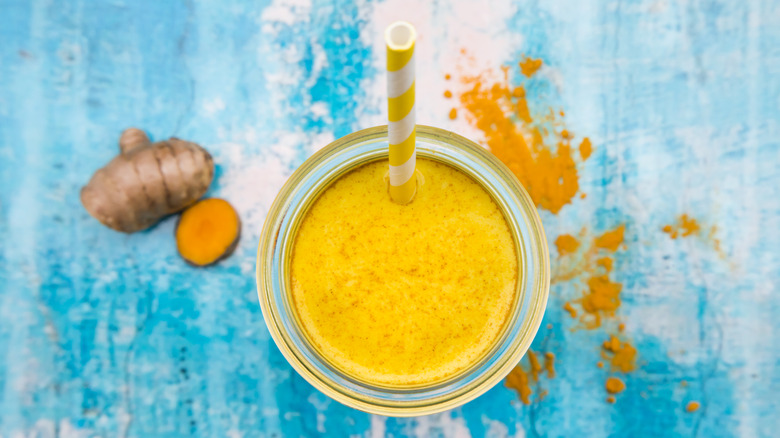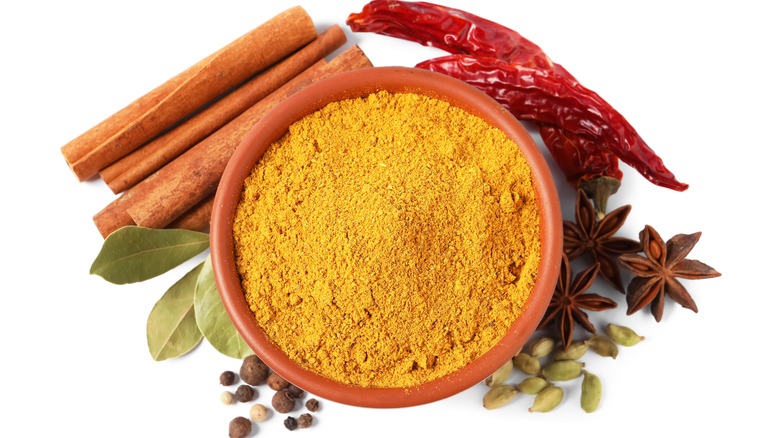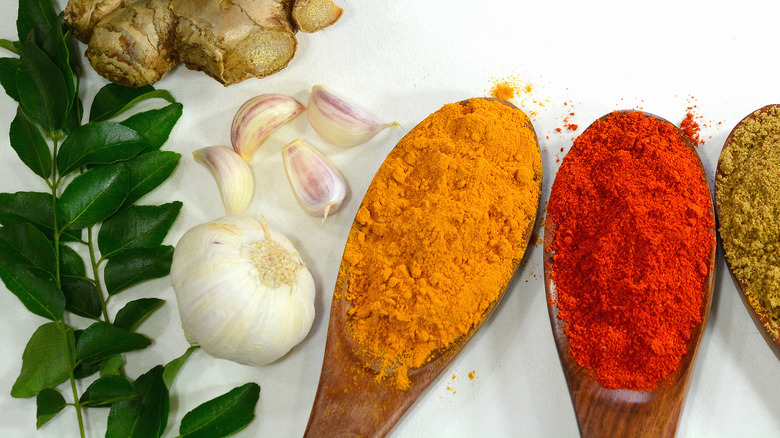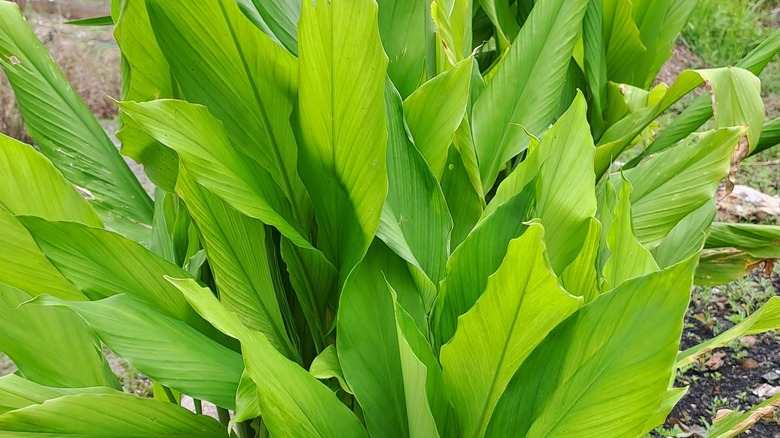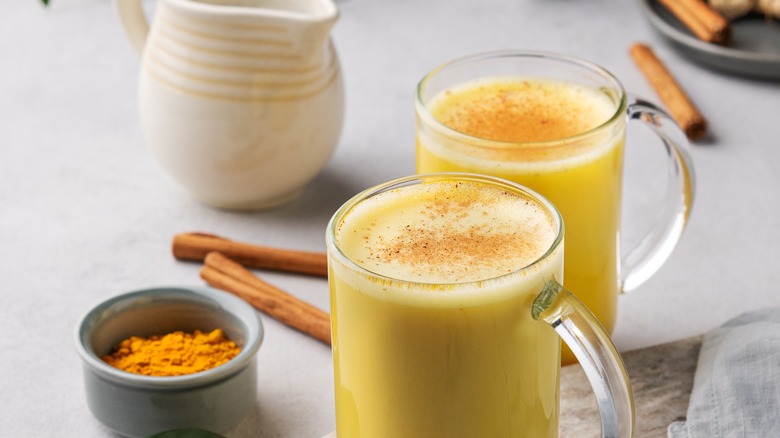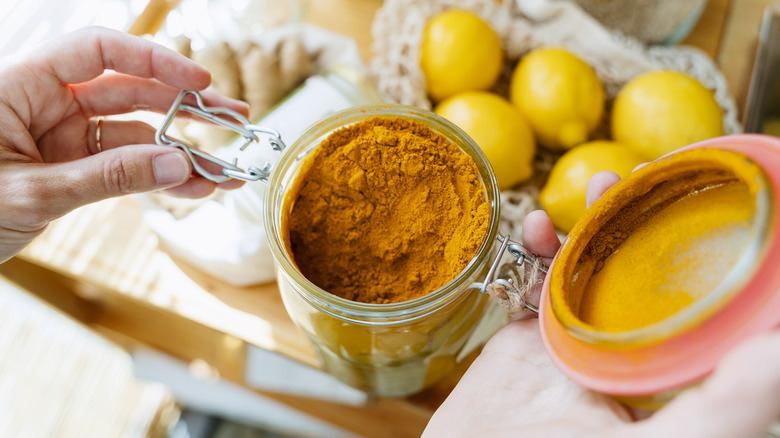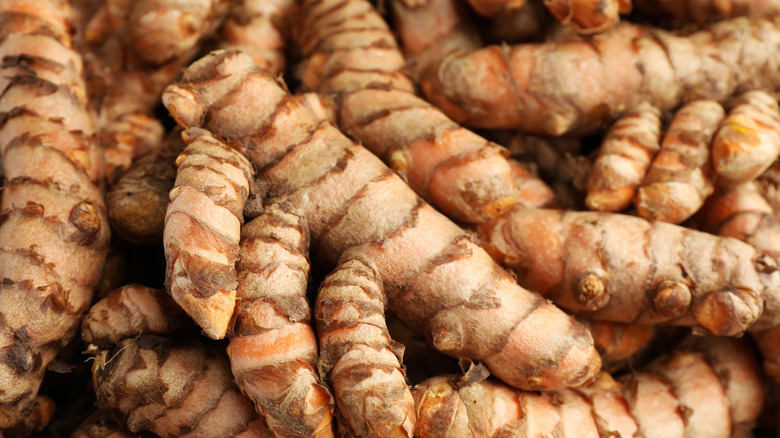Your Complete Guide To Using Turmeric In The Kitchen
Turmeric is all the rage in the health food circle. You can get turmeric in the form of shots, cubes, smoothie additives, cookies, and more. You can also find supplements as capsules, tablets, liquids, and gummies. Beyond knowing that it's good for you and everyone "should" be eating more of it (which is not necessarily true in the large amounts found in supplements), many people scratch their heads when it comes to this bright yellow-orange seasoning, even if it's in their own cupboard.
The good news is, it's not hard to learn to incorporate this age-old spice into your daily cooking routine. Yes, you can make curries and soups that leverage its health benefits and warm, earthy flavor. However,it also works well in milky drinks, desserts, breads, and more. It's time to bring turmeric to the forefront of your culinary experience by understanding exactly what it is and how you can use it.
What is turmeric?
Turmeric is a spicy yellow-orange root that comes from the plant of the same name (Curcuma longa). It is a member of the ginger family and shares some of its same spicy, earthy, deep-flavored attributes. It is native to Indonesia and southern India. It is a perennial plant that normally inhabits monsoon forests, where it is wet and warm most of the time. With a height and spread of 3-4 feet, it is a compact bushy grower that looks a bit like a canna lily with a pink, ginger-like flower.
Prepared in many different ways, turmeric is used in curry and mustard for its flavor and coloration. It is also used in items you wouldn't expect. For example, it is the reason potato bread is yellow. It is also used in pickles, relishes, and a huge variety of other dishes. Today, turmeric is grown primarily in India, China, Myanmar, Nigeria, and Bangladesh.
A brief history of turmeric cultivation and use
Turmeric has a long history stretching back almost four millennia. It first became cultivated in India, later spreading to China and along spice routes to other parts of Eurasia and to Africa. It was used in India for a variety of purposes, from cuisine and textiles to medicine and religion, including as a symbolic topical application to bring luck. The Egyptians reportedly used it to treat wounds and as a fabric dye some 3,500 years ago, given its bright and staining properties.
Eventually, it spread all over the world. Today, for instance, it comprises a staple spice in the Ethiopian flavor palette. It is now grown in Central America and the Caribbean, among other equatorial locales. Turmeric has been called different names in different places, but in English it stems from the Latin phrase terra merita, meaning "meritorious earth" because it looks like a paint pigment. Indeed, the artsy fartsy crowd might be interested to know you can paint with it.
The flavor of turmeric
Warm, earthy, and hot, turmeric's flavor. It is not just spicy, however; its flavor is often described as peppery. Notes of citrus also play in, and like salt, turmeric can help enhance the flavors of other seasonings in a dish. While bitter as well, turmeric is pleasantly so, offering a strong bite that offsets pepper and umami flavors. The flavor of powder is less sharp and potent than that of raw root and may diminish with time.
Somewhat counterintuitively, turmeric also works well in sweet dishes. Much like naturally bitter chocolate, it pairs well with honey, syrup, or sugar and traditionally dessert-y spices such as cinnamon, nutmeg, and cloves, also enhancing these tastes and aromas. Rather than working as the hero ingredient (thank you, Paul Hollywood), turmeric is best as an ingredient added subtly alongside other flavors in desserts, such as in the dough of cinnamon buns or ginger puddings.
Common varieties of turmeric
There are several varieties of turmeric that the experimental chef might want to try. Not only does Curcuma longa have a close sibling, Curcuma aromatica or wild turmeric, but there are different cultivars (e.g. different breeds of the species) as well.
While more than 50 such cultivars exist, most home cooks will only encounter one or two of these in the course of their normal shopping day. These include Madras, preferred in the U.K. and Middle East, and Alleppey, preferred in the U.S. While the former has a brighter color, the latter has a stronger flavor and aromatic profile.
If you make the effort to source different types of turmeric, though, you'll discover quite a few. These include black turmeric (Curcuma caesia) and white turmeric (Curcuma zedoaria), as well as a variety of color gradations, influenced by the growing conditions of the part of the world in which the root was cultivated. Note that not all substances marketed as turmeric are for cooking; some are intended medicinally. You should always check an ingredient carefully before using it in food.
Available forms of turmeric
Turmeric comes in several forms, most of which are available at today's modern grocery store. Raw root is often available in the produce section near the ginger. If you can't find it at your grocery store, try a shop dedicated to Indian or Southeast Asian cuisine, where you're more likely to find it raw.
If you don't want to bother with selecting, preparing, and storing the raw root, though, you can also purchase dried turmeric in powdered or sliced form. Dried slices are harder to source, but you can find them online if not at a health food store. You can also find the whole roots dried and packaged either online or in herbal shops. Almost any store will have at least a bottle of ground turmeric in the spice aisle, though, so if you're just learning to use it, make that your first stop.
You will usually find some form of turmeric in the tea aisle as well. However, in that case, it will be in the form of looseleaf or bagged tea rather than on its own. This is a great way to get your antioxidants, even though you can't use the prefab tea for cooking.
How turmeric is processed
Turmeric root isn't simply dug up and sold. It must undergo a complex preparation process before it gets sold in the form most people know it today: as a ground yellow-orange powder. First, rhizomes are boiled or steamed to reduce their pungent aroma. In the olden days, turmeric was traditionally cooked up with leaves and cow dung, the latter of which reacted with the natural turmeric compounds to produce a desirable end product (no pun intended). Fortunately, that's no longer the case in modern processing.
Instead, roots are cooked with a simple solution of water containing a low percentage of sodium bicarbonate, or as you might know it, baking soda. Afterward, they are left to dry, then polished, and finally ground up and bottled for sale.
According to some sources, Indian turmeric is the best in the world, producing much of the global supply thereof (and subsequently consuming about 80 percent of it). However, as long as you buy dried or powdered turmeric from a reputable supplier, chances are good that you'll get a product of decent quality. What counts as reputable? Make sure they have an address on the package in the store, and look them up online if you're not sure.
How to choose the best turmeric at the store
There are many turmeric options available at large stores, and you'll find even more online. Which one you choose will depend on what you're looking to make or accomplish health-wise. The best indication of what kind of turmeric you need will come from the recipe you're using. For instance, many curries call for powdered root, while you might want to add fresh to a smoothie. Again, follow the lead of whatever chef created your recipe for the best results.
That said, many people suggest raw turmeric root, as it is more nutrient-dense than the dried and powdered version (due to its higher concentration of curcumin), for use in the kitchen. If you can find a recipe that uses raw turmeric, you might want to. Make sure to check for firm, evenly colored roots free of dings or soft spots. If buying dried, check the best-by date to make sure the spice is still within its useful window.
Common uses for turmeric in the kitchen
Turmeric is wonderful in soups, stews, curries, bread, and even sweet cakes, such as Middle Eastern sfouf. It is a great addition to meat dishes and tagines, where its pungent and earthy flavor warms up chicken, beef, lamb, or goat. (Trust that if you have access to an African or Middle Eastern meat market, you should really put goat on your protein rotation and combine it with curry whenever possible.)
However, turmeric's use is not just confined to food from Africa, Asia, or the Middle East. Ree Drummond even uses it in her mac and cheese, proof positive that turmeric needn't be relegated to the aisles of health food stores. You can also mix it into everyday foods such as pasta, eggs, rice, veggie dip, and smoothies. Turmeric makes for a sharp and interesting cocktail if you like to experiment. Think vodka, lime, maple syrup, tonic water, and turmeric for a sharp, summery, herbal beverage that's perfect for drinks on the patio.
When preparing turmeric fresh, you will usually want to mince or grate it up small. Like its cousin the ginger root, turmeric is quite firm (as it should be if it's actually fresh), so grating it using a microplane or cheese grater is a good idea when adding raw root to dishes. If you prefer, you can pulp the root and squeeze it through a nut bag to collect the juice.
Turmeric milk: Your Ayurvedic sleep aid
Ever heard of golden milk? Wonder where it got that name? If you guessed turmeric, gold star. Golden milk, popularly recommended as a warming and calming beverage to help promote sleep and approved by Ayurvedic medicine, is easy to make and surprisingly delicious, once you get over the shock of mixing turmeric's strong flavor with smooth milk and sweeteners. Everyone should know how to make it!
Happily, it's not hard. You'll need some milk. Many recipes recommend vegan milks, but dairy will do just fine. For one serving, you will want 2 cups of milk, as well as a teaspoon of ground turmeric. Other additions include honey, maple syrup, cinnamon, black pepper, coconut oil, and ginger. These, however, are optional ... the only ingredients you can't skip are the milk and turmeric. Mix them all up together on the stovetop and bring to a simmer, then allow the pot to gently simmer for about 10 minutes until the flavors blend. Pour into a mug and enjoy while hot.
Curry and other turmeric spice mixes
Want to make your own curry powder? Turmeric to the rescue. It is one of the main ingredients in curry (at least, the yellow kind) and is what gives it that bright flavor. In addition to powdered turmeric root, most curry blends also call for coriander, cumin, ginger, mustard, black pepper, cinnamon, cardamom, and cayenne or chili powder.
You can also use it to make a simple vegetable seasoning by combining ground turmeric, paprika, oregano, and garlic powder in a 2:2:5:4 ratio. Additionally, you can make a golden milk spice mix to have ready when you want to make your soothing turmeric nightcap. All you have to do is combine the dry ingredients in the ratios called for in your preferred recipe, multiplied out by however much you want to keep on hand. Once mixed up, place it in an airtight container and store it as you would other spices.
Lastly, you might want to make an all-natural anti-inflammatory cocktail. It is composed of turmeric, ginger, and pepper in a 5:2:1 ratio. You can use this in soups, stews, and curries, but you can also add it to less traditional fare, such as savory oatmeal, green tea lattes, or tofu scrambles.
Substitutes for turmeric
The best substitute for turmeric is, where possible, turmeric. Thus, if you cannot find dried turmeric in your cupboard but you have fresh, or vice versa, go ahead and use it in another state. The general rule for substituting fresh for dried seasonings is to use a 3:1 ratio. If you need 1 tablespoon of ground turmeric, for instance, use 3 tablespoons grated fresh turmeric. Similarly, if you need 1 tablespoon of fresh, use ⅓ tablespoon dried (which translates to a teaspoon).
While turmeric is pretty much its own thing, you can work around its absence if you really need to. Common substitutes for flavor include curry powder (as it contains a high percentage of turmeric) or, if you don't have that, a ginger-cumin blend. For color, go for saffron. Paprika will also lend earthy heat, while mustard (containing turmeric as well) can help you with color. Galangal, a relative of both ginger and turmeric, is another option.
Growing your own turmeric
Yep, you can grow your own turmeric. In most places in the U.S., it needs to grow indoors. However, it will grow in USDA zones 8-11 as a perennial outdoors, which means you can plant it in your garden in much of the American South as well as the West Coast. It is not a particularly fussy plant, and growing it yourself will give you access to fresh rhizomes much of the year.
To grow turmeric, make sure it gets full sun or partial shade, and keep it moist at all times. It can handle being wet, though you'll want to plant it in well-drained soil. If you are growing it inside in pots, you can move it outside for the summer once all chance of frost has passed for the year.
Do note when handling turmeric that it stains easily. That goes for harvesting the roots and using them in the kitchen. Luckily, you can get common food stains such as turmeric out pretty easily with baking soda, vinegar, or alcohol.
Health benefits of turmeric
Turmeric has been employed since ancient times by Indian and Chinese traditional healers. It was used for respiratory and digestive issues, skin, and joints. Today, it is touted as an aid for many different health problems, from arthritis to GI conditions, allergies and mood disorders, and more.
Studies have also found that turmeric works as a sleep aid. According to a study published in the journal Molecular Nutrition & Food Research, turmeric extract increases non-REM sleep in mice, indicating it is a potential solution to insomnia in humans. Some turmeric proponents point out that due to its mood-regulating effects, it is also helpful for sleep in that way, hence its place in turmeric milk as a no-proof nightcap.
These health benefits stem mainly from curcuminoids, the most common of which is curcumin, and other closely related substances that fall into that group. Research is as yet unclear on its exact properties and how much it helps different conditions, because turmeric is hard to study: unstable, not particularly bioavailable, and often tainted with other substances that muddy results.
However, studies do seem to indicate that turmeric can help fight cancer cells. And given its long use and lack of serious side effects, it can't hurt to add it to your diet in reasonable amounts (e.g. what you'd use in cooking).
Storing turmeric to last
Both spices and seasonings break down over time, but there are ways to store spices for the best flavor and longest shelf life. Admittedly, it is important to know that no matter what you do, the flavor of dried spices will diminish with time. Not only do compounds naturally evaporate, but exposure to direct sun can speed the process of chemical compound breakdown along. Although this is great when it comes to, say, killing bacteria in your laundry, it's not so great for your seasonings.
As such, you should always keep dried spices in a cool, dry, dark place. Protecting them from moisture will keep them from spoiling, while avoiding light and heat will protect the flavor-generating curcuminoids longer. If you feel harassed by the idea of digging in a cupboard you're your seasonings every time you need them, consider using a pull-out drawer for easy access that still keeps spices in darkness most of the time. Just make sure to use a drawer organizer so you're not banging glass bottles around.
If you're storing fresh turmeric root, wash and dry it thoroughly, then wrap it in a paper towel and put it in a Ziploc bag, making sure to squeeze out all the air. It will keep this way for a few weeks in the fridge or 6 months in the freezer.
Nutritional information
As a spice, turmeric contains very few calories but a lot of health benefits. You can add it with abandon to your foods without measurably changing their macronutrients or overall caloric load, while also adding a ton of vitamins and minerals. To be exact, a tablespoon of ground and powdered turmeric contains about 29 calories. That tablespoon also contains a significant percentage of your daily requirements for manganese (26 percent), iron (16 percent), potassium (5 percent), and vitamin C (3 percent).
There are few risks associated with taking turmeric. However, in large amounts, it can upset your stomach. It is also contraindicated for some health conditions, such as gallstones or bile passage obstruction. The same is true for those with diabetes or on blood thinners. No matter what, you should always talk to a healthcare practitioner before self-prescribing large amounts of any supplement. In the levels you'll find in food, however, turmeric is generally considered safe for consumption for everyone.
